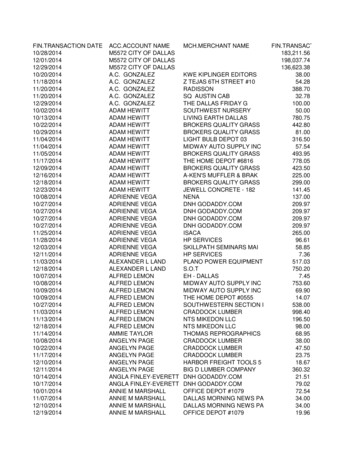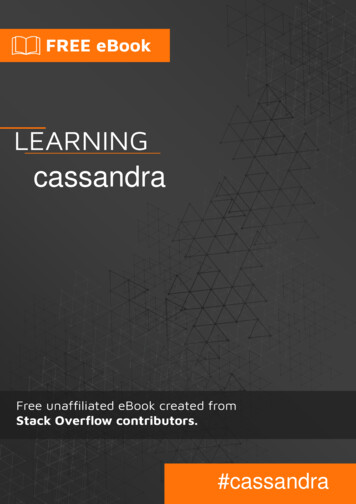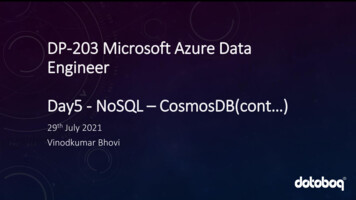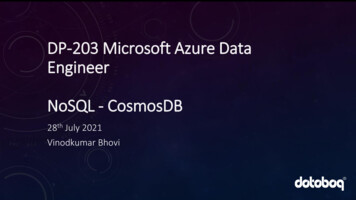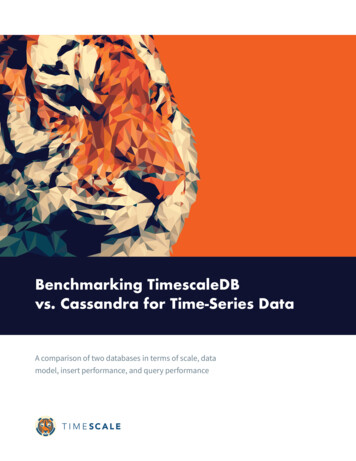
Transcription
Benchmarking TimescaleDBvs. Cassandra for Time-Series DataA comparison of two databases in terms of scale, datamodel, insert performance, and query performance
Overview 3Scaling patterns 5Data model 5Insert performance 7Query performance 10Summary 13Next steps 14Footnotes 15
OverviewTime-series data is emerging in more and more applications, including IoT, DevOps, Finance, Retail,Logistics, Oil and Gas, Manufacturing, Automotive, Aerospace, SaaS, even machine learning and AI. Ifyou are investing in a time-series database, that likely means you already have a meaningful amountof time-series data piling up quickly and need a place to store and analyze it.With its simple data partitioning and distribution architecture, highly tunable consistency settings,and strong cluster management tooling, Cassandra is legendary for its scalability. Developers oftenforego the expressiveness of SQL for the intoxicating power of being able to add write nodes to aCassandra cluster with a single command. Moreover, Cassandra’s ability to provide sorted wide rows(more on this later) makes it a compelling use case for a scalable time-series data store.Therefore, Cassandra’s ease of use, staying power, and potential to handle time-series data wellthrough its sequentially sorted wide rows make it a natural comparison to TimescaleDB. In thispaper, we dive deeper into using Cassandra vs. TimescaleDB for time-series workloads by comparingscaling patterns, data model, insert performance, and query performance of each database.Benchmarking setupWe start by comparing 5 node clusters for each database. Then, we benchmark a few different clusterconfigurations because the scaling properties of 5 node TimescaleDB and 5 node Cassandra are notperfectly analogous.Here are the specs we used for these tests: 2 remote client machines, both on the same LAN as the databases Azure instances: Standard D8s v3 (8 vCPUs, 32 GB memory) 5 TimescaleDB nodes, 5/10/30 Cassandra nodes (as noted) 4 1-TB disks in a raid0 configuration (EXT4 filesystem) Dataset: 4,000 simulated devices generated 10 CPU metrics every 10 seconds for 3 full days( 100M reading intervals, 1B metrics) For TimescaleDB, we set the chunk size to 12 hours, resulting in 6 total chunks (more here)Benchmarking TimescaleDB vs. Cassandra3
The resultsBefore moving forward, let’s start with a visual preview of how 5 TimescaleDB nodes fare againstvarious sizes of Cassandra clusters:Now, let’s look a bit further into how TimescaleDB and Cassandra achieve scalability.Benchmarking TimescaleDB vs. Cassandra4
Scaling patternsCassandra provides simple scale-out functionality through a combination of its data partitioning,virtual node abstraction, and internode gossip. Adding a node to the cluster redistributes the datain a manner transparent to the client and increases write throughput more-or-less linearly (actuallysomewhat sub-linear in our tests)¹. Cassandra also provides tunable availability with its replicationfactor configuration, which determines the number of nodes that have a copy of a given piece of data.PostgreSQL and TimescaleDB support scaling out reads by way of streaming replication. Each replicanode can be used as a read node to increase read throughput. Although PostgreSQL does not nativelyprovide scale-out write functionality, users can often get the additional throughput they need by usingRAID disk arrays or leveraging the tablespace functionality provided by PostgreSQL.In addition, unlike PostgreSQL, TimescaleDB allows users to (elastically) assign multiple tablespacesto a single hypertable if desired (e.g., multiple network-attached disks), creating the potential formassively scaling disk throughput on a single TimescaleDB instance. Moreover, as we’ll see, the writeperformance a single TimescaleDB instance provides for time-series data is quite often more thansufficient for a production workload—and that’s without some of the traditional NoSQL drawbacks thatcome with Cassandra.Data modelCassandra is a column family store. Data for a column family, which is roughly analogous to a tablein relational databases, is stored as a set of unique keys. Each of these keys maps to a set of columnswhich each contain the values for a particular data entry. These key- column-set tuples are called“rows” (but should not be confused with rows in a relational database).In Cassandra, data is partitioned across nodes based on the column family key (called the primary orpartition key). Additionally, Cassandra allows for compound primary keys, where the first key in thekey definition is the primary/partition key, and any additional keys are known as clustering keys. Theseclustering keys specify columns on which to sort the data for each row.Let’s take a look at how this plays out with the dataset we use for our benchmarks. We simulate adevops monitoring use case where 4,000 unique hosts report 10 CPU metrics every 10 seconds over thecourse of 3 days, resulting in a 100 million row dataset.Benchmarking TimescaleDB vs. Cassandra5
In our Cassandra model, this translates to us creating a column family like this:CREATE TABLE measurements (series id text,timestamp ns bigint,value double,PRIMARY KEY(series id, timestamp ns));The primary key, series id, is a combination of the host, day, and metric type in the formathostname#metric type#day. This allows us to get around some of the query limitations of Cassandradiscussed above, particularly the weak support for joins, indexes, and server side rollups. Byencoding the host, metric type, and day into the primary key, we can quickly and easily accessthe subset of data we need and execute any further filtering, aggregation, and grouping moreperformantly on the client side.We use timestamp ns as our clustering key, which means that data for each row is ordered bytimestamp as we insert it, providing optimal time range lookups. This is what a row of 3 values of thecpu guest metric for a given host on a given day would look like.This is what we meant when we mentioned the wide row approach earlier. Each row contains multiplecolumns, which are themselves sets of key-value pairs. The number of columns for a given row growsas we insert more readings corresponding to that row’s partition key. The columns are clustered bytheir timestamp, guaranteeing that each row will point to a sequentially sorted set of columns.This ordered data is passed down to our custom client, which maintains a fairly involved client-sideindex to perform the filtering and aggregation that is not supported in a performant manner byCassandra’s secondary indexes. We maintain a data structure that essentially duplicates Cassandra’sprimary key- metrics mapping and performs filtering and aggregations as we add data from ourCassandra queries. The aggregations and rollups we do on the client side are very simple (min, max,avg, groupby, etc.), so the vast majority of the query time remains at the database level. (In otherwords, the client-side index works, but also takes a lot more work.)Benchmarking TimescaleDB vs. Cassandra6
Insert performanceUnlike TimescaleDB, Cassandra does not work well with large batch inserts. In fact, batching as aperformance optimization is explicitly discouraged due to bottlenecks on the coordinator node if thetransaction hits many partitions. Cassandra’s default maximum batch size setting is very small at 5KB.Nonetheless, we found that a small amount of batching (batches of 100) actually did help significantlywith insert throughput for our dataset, so we used a batch size of 100 for our benchmarks.To give Cassandra a fair test against TimescaleDB, which allows for far larger batch sizes (we use10,000 for our benchmarks), we ramped up the number of concurrent workers writing to Cassandra.While we used just 8 concurrent workers to maximize our write throughput on TimescaleDB, weused 1,800 concurrent workers (spread across multiple client machines) to max out our Cassandrathroughput. We tested worker counts from 1 up to 1,800 before settling on 1,800 as the optimalnumber of workers for maximizing write throughput. Any number of workers above that causedunpredictable server side timeouts and negligible gains (in other words, the tradeoff of latency forthroughput became unacceptable).To avoid client-side bottlenecks (e.g., with data serialization, the client-side index, or networkoverhead), we used 2 client VMs, each using our Golang benchmarker with 900 goroutines writingconcurrently. We attempted to get more throughput by spreading the client load across even moreVMs, but we found no improvements beyond 2 boxes.Since writes are sharded across nodes in Cassandra, its replication and consistency profile is a bitdifferent than that of TimescaleDB. TimescaleDB writes all data to a single primary node which thenreplicates that data to any connected replicas through streaming replication. Cassandra, on the otherhand, shards the writes across the cluster, so no single replica stores all the cluster’s data. Instead,you define the replication factor for a given keyspace, which determines the number of nodes thatwill have a copy of each data item. You can further control the consistency of each write transactionon the client side by specifying how many nodes the client waits for the data to be written to.PostgreSQL and TimescaleDB similarly offer tunable consistency.Given these significant differences, it’s difficult to achieve a truly apples-to-apples comparison of a 5node TimescaleDB cluster vs. a 5 node Cassandra cluster. We decided on comparing a TimescaleDBcluster with 1 primary and 4 read replicas, synchronous replication, and a consistency level of ANY1 against a 5 node Cassandra cluster with Replication Factor set to 2 and a consistency level of ONE.In both cases, clients will wait on data to be copied to 1 replica. Eventually data will be copied to 2nodes in the case of Cassandra, while data will be copied to all nodes in the case of TimescaleDB.Benchmarking TimescaleDB vs. Cassandra7
In theory, then, Cassandra should have an advantage in insert performance since writes will be shardedacross multiple nodes. On the read side, TimescaleDB should have a small advantage for very hot setsof keys (given they may be more widely replicated), but the total read throughput of the two should betheoretically comparable.In practice, however, we find that TimescaleDB has an advantage over Cassandra in both reads andwrites, and it’s large.Let’s take a look at the insert rates for each cluster.Despite Cassandra having the theoretical advantage of sharded writes, TimescaleDB exhibits 5.4xhigher write performance than Cassandra. That actually understates the performance difference.Since TimescaleDB gets no write performance gains from adding extra nodes, we really only need a 3node TimescaleDB cluster to achieve the same availability and write performance as our Cassandracluster, making the real TimescaleDB performance multiplier closer to 7.6x.This assumes that Cassandra scales perfectly linearly, which turns out to not quite be the case in ourexperience. We increased our Cassandra cluster to 10 then 30 nodes while keeping TimescaleDB at acool 5 nodes.Benchmarking TimescaleDB vs. Cassandra8
Even a 30 node Cassandra cluster performs nearly 27% slower for inserts against a singleTimescaleDB primary. With 3 TimescaleDB nodes — the maximum with TimescaleDB needed toprovide the same availability as 30 node Cassandra with a Replication Factor of 2 — we now see thatCassandra needs well over 10x (probably closer to 15x) the resources as TimescaleDB to achievesimilar write rates.For each node in these benchmarks, we paid for an Azure D8s v3 VM ( 616.85/month) as well as 4attached 1TB SSDs ( 491.52/month). The minimum number of TimescaleDB nodes needed to achieveits write throughput and availability in the above chart is 3 ( 3,325.11/month), while the minimumnumber of Cassandra nodes required to achieve its highest write throughput and availability in theabove chart is 30 ( 33,251.10/month). In other words, we paid 29,925.99 more for Cassandra to get73% as much write throughput as TimescaleDB.Put another way, TimescaleDB exhibits higher inserts at 10% of the cost of Cassandra.TimescaleDB: Higher inserts at 1/10 the cost of CassandraBenchmarking TimescaleDB vs. Cassandra9
Query performanceCassandra is admittedly less celebrated than SQL databases for its strength with analytical queries,but we felt it was worth diving into a few types of queries that come up frequently with time-seriesdatasets. For all queries, we used 4 concurrent clients per node per query. We measured both themean query times and the total read throughput in queries per second.Simple rollups: TimescaleDB competitive (up to 4x faster)We’ll start with the mean query time on a few single rollup (i.e., groupby) queries on time. We ranthese queries in 1000 different permutations (i.e., random time ranges and hosts).LOWER query times BETTER performanceCassandra holds its own here, but TimescaleDB is markedly better on 2 of the 3 simple rollup typesand very competitive on the other. Even in simple time rollup queries where Cassandra’s clusteringkeys should really shine, TimescaleDB’s hypertables outperform.Deducing the total read throughput of each database is fairly intuitive from the above chart, but let’stake a look at the recorded QPS of each queryset just to make sure there are no surprises.Benchmarking TimescaleDB vs. Cassandra10
HIGHER queries per second BETTER performanceWhen it comes to read throughput, TimescaleDB maintains its markedly better performance here.Rollups on time and device: TimescaleDB 10x-47x fasterBringing multiple rollups (across both time and device) into the mix starts to make both databasessweat, but TimescaleDB has a huge advantage over Cassandra, especially when it comes to rolling upmultiple metrics. Given the lengthy mean read times here, we only ran 100 for each query type.LOWER query times BETTER performanceBenchmarking TimescaleDB vs. Cassandra11
We see a similar story for read throughput.HIGHER queries per seconds BETTER performanceComplex analytical queries: TimescaleDB 3100x-5800x fasterWe also took a look at 2 slightly more complex queries that you commonly encounter in time-seriesanalysis. The first (‘lastpoint’) is a query that retrieves the latest reading for every host in the dataset,even if you don’t a priori know when it last communicated with the database³. The second (‘groupbyorderby-limit’) does a single rollup on time to get the MAX reading of a CPU metric on a per-minutebasis for the last 5 intervals for which there are readings before a specified end time⁴. Each querysetwas run 100 times.Benchmarking TimescaleDB vs. Cassandra12
And the read throughput.HIGHER queries per second BETTER performanceFor these queries, Cassandra is clearly not the right tool for the job. TimescaleDB can easily leveragehypertables to narrow the search space to a single chunk, using a per-chunk index on host and timeto gather our data from there. Our multi-part primary key on Cassandra, on the other hand, providesno guarantee that all of the data in a given time range will even be on a single node. In practice, forqueries like this that touch every host tag in the data set, we end up scanning most, if not all, of thenodes in a cluster and grouping on the client side.SummaryAs we see, 5 TimescaleDB nodes outperform a 30 node Cassandra cluster, with higher inserts, up to5800x faster queries, 10% the cost, a much more flexible data model, and full SQL.Cassandra’s turnkey write scalability comes at a steep cost. For all but the simplest rollup queries,our benchmarks show TimescaleDB with a large advantage, with average query times anywherefrom 10 to 5,873 times faster for common time-series queries. While Cassandra’s clustered wide rowsprovide good performance for querying data for a single key, it quickly degrades for complex queriesinvolving multiple rollups across many rows.Additionally, while Cassandra makes it easy to add nodes to increase write throughput, it turns outyou often just don’t need to do that for TimescaleDB. With 10–15x the write throughput of Cassandra,a single TimescaleDB node with a couple of replicas for high availability is more than adequate fordealing with workloads that would require a 30 node fleet of Cassandra instances to handle.However, Cassandra’s scaling model does offer nearly limitless storage since adding more storagecapacity is as simple as adding another node to the cluster. A single instance of TimescaleDB currentlytops out around 50–100TB. If you need to store petabyte scale data and can’t take advantage ofretention policies or rollups, then massively clustered Cassandra might be the solution for you.Benchmarking TimescaleDB vs. Cassandra13
Cassandra was a pleasure to work with in terms of scaling out write throughput. But attaining that atthe cost of per-node performance, the vibrant PostgreSQL ecosystem, and the expressiveness of fullSQL simply does not seem worth it.We try to be as open as we can about our data models, configurations, and methodologies so readerscan raise any concerns they may have about our benchmarks and help us make them as accurateas possible. As a time-series database company we’ll always be quite interested in evaluating theperformance of other solutions.Next stepsIn this paper, we performed a detailed comparison of TimescaleDB and Cassandra. One of the worstmistakes a business can make is investing in a technology that will limit it in the future, let alone bethe wrong fit today. That’s why we encourage you to take a step back and analyze your stack beforeyou find your database infrastructure crumbling to the ground.If you are ready to get started with TimescaleDB, follow the instructions below. If you have anyquestions along the way, please contact us.Where to go from here. Install TimescaleDB Join the Slack channel Reach out to hello@timescale.com and let us know how we can helpAdditional resources Benchmark using the Time Series Benchmark Suite (TSBS) Follow our blog for database insights, engineering updates, tutorials, and moreBenchmarking TimescaleDB vs. Cassandra14
Footnotes1. We tested with up to 30 Cassandra nodes and saw performance that wasn’t exactly linear butclose enough for Cassandra’s horizontal scalability to be compelling.2. For example, a standard time range query like “SELECT timestamp ns, value FROM %s WHEREseries id host 12#usage user#2016–01–02 AND timestamp ns 1451692800000000000 ANDtimestamp ns 1451692810000000000” would only work if timestamp ns were a clusteringkey or a secondary index. Similarly, if we wanted to filter on value, we would need to define aclustering key or secondary index for it.3. An example SQL query might help clarify this: “SELECT DISTINCT ON (t.hostname) * FROM tags tINNER JOIN LATERAL(SELECT * FROM cpu c WHERE c.tags id t.id ORDER BY time DESC LIMIT 1)AS b ON true ORDER BY t.hostname, b.time DESC”.4. And a bit more SQL for clarity: “SELECT date trunc(‘minute’, time) AS minute, max(usage user)FROM cpu WHERE time ‘2016–01–01 19:47:52.646325 -7:00’ GROUP BY minute ORDER BYminute DESC LIMIT 5”.Benchmarking TimescaleDB vs. Cassandra15
Benchmarking TimescaleDB vs. Cassandra 8 In theory, then, Cassandra should have an advantage in insert performance since writes will be sharded across multiple nodes. On the read side, TimescaleDB should have a small advantage for very hot sets of keys (given they may be more widely replicated), but the total read throughput of the two should be

